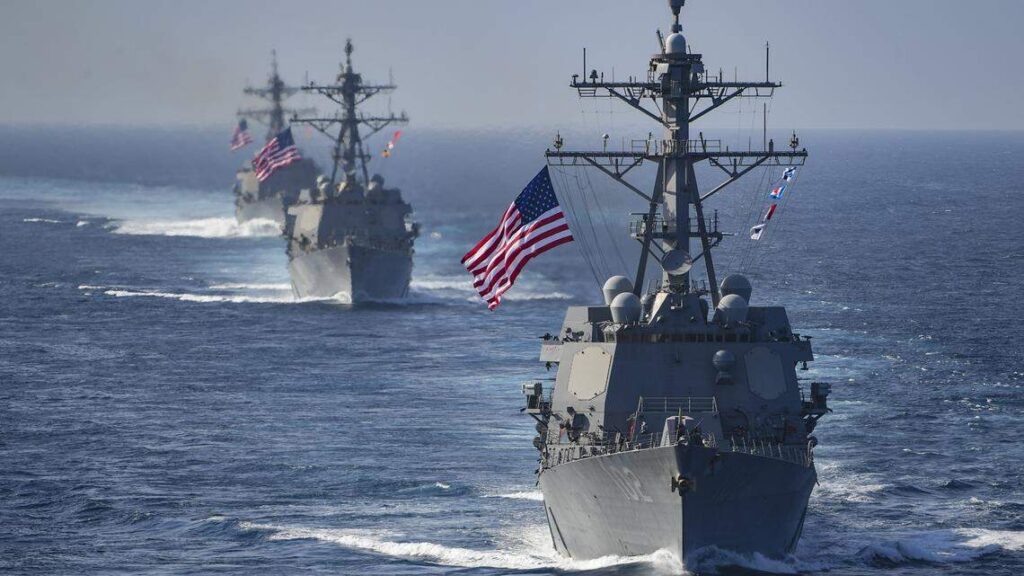CARACAS – Three U.S. Navy guided-missile destroyers are expected to take positions off the coast of Venezuela this week, forming the centerpiece of a new operation ordered by President Donald Trump to combat drug cartels across Latin America.
The warships — the USS Sampson, USS Jason Dunham and USS Gravely — are Arleigh Burke class destroyers, the backbone of the Navy’s surface fleet. Known for their versatility and advanced combat systems, the ships are designed to counter threats from air, land, sea and even undersea simultaneously. Their arrival adds a potent mix of firepower, surveillance and flexibility to a region increasingly viewed by the Trump administration as a corridor for narcotics smuggling and transnational crime.
According to U.S. defense officials cited by Reuters, about 4,000 sailors and Marines will be committed to the mission, which will also include P-8 Poseidon reconnaissance aircraft, additional warships, and at least one nuclear-powered attack submarine. Together, the deployment represents one of the most robust naval task forces positioned in the Caribbean in recent years.
Here are the key facts about the warship’s capabilities:
Sailors assigned to the Arleigh Burke-class guided-missile destroyer USS Sampson handle lines during a fueling-at-sea in the Pacific Ocean in October 2017. Sipa USA U.S. Navy/Sipa USA
The Aegis edge
At the heart of each destroyer is the Aegis combat system, a combination of radar, computing power and missile technology that allows for real-time detection and engagement of multiple threats. Developed during the Cold War and continuously upgraded, Aegis provides the ships with a level of situational awareness and automated command that few navies in the world can match.
The system’s phased-array radar can track hundreds of airborne and surface contacts simultaneously, feeding data to the ship’s combat information center. That information enables commanders to launch defensive or offensive strikes in seconds, whether intercepting an incoming cruise missile, engaging hostile aircraft, or directing Tomahawk missiles at land targets hundreds of miles away.
The guided-missile destroyer USS Jason Dunham fires its Mark 45 5-inch gun as part of a live-fire demonstration in September 2018. Sipa USA U.S. Navy/Sipa USA
The USS Sampson
Commissioned in 2007, the Sampson is a Flight IIA variant of the Arleigh Burke class and one of the earlier destroyers to feature helicopter hangars, significantly extending its reach. Named for Rear Admiral William T. Sampson, who commanded U.S. naval forces during the Spanish-American War, the ship adds modern capabilities to its historical lineage.
The ship’s arsenal centers on a 96-cell vertical launch system, which can be loaded with a diverse mix of weapons. That includes Tomahawk cruise missiles for long-range land attacks, standard missiles for air and missile defense, and ASROC, Anti-Submarine Rocket missiles for undersea warfare. Sampson also carries a 5-inch/62-caliber deck gun for surface use and naval gunfire support, as well as a Phalanx Close-In Weapon System — a rapid-firing Gatling gun — for last-ditch defense against missiles or aircraft.
Sampson’s embarked MH-60R Seahawk helicopters are equipped with sonar, torpedoes and advanced sensors that extend the ship’s anti-submarine capabilities far beyond the horizon.
An MH-60R Seahawk helicopter approaches the flight deck of the guided-missile destroyer USS Gravely on the Balktic Sea in April 2019. Sipa USA U.S. Navy/Sipa USA
The USS Jason Dunham
The Dunham, commissioned in 2010, honors Marine Corps Corp. Jason Dunham, who posthumously received the Medal of Honor for sacrificing his life to save fellow Marines in Iraq. The destroyer is one of the Navy’s newest warships.
Built at Bath Iron Works in Maine, Jason Dunham measures 510 feet in length and displaces more than 9,000 tons at full load. The ship is powered by four gas turbines that allow speeds exceeding 30 knots, enabling rapid maneuverability in dangerous waters.\
The Dunham’s combat systems mirror those of her sister ships, with the Aegis system at the core, backed by the same 96-cell VLS. With a crew of about 380, the Dunham integrates advanced electronic warfare suites, towed sonar arrays, and layered missile defenses, allowing the destroyer to operate independently or as part of a larger strike group.
The USS Gravely
Commissioned in 2010, the Gravely honors Vice Admiral Samuel L. Gravely Jr., the first African American to command a U.S. Navy warship, a major fleet, and eventually a numbered fleet. Like the Dunham, the Gravely is equipped with the latest Aegis systems, a 96-cell launcher, and the ability to employ Tomahawk land-attack missiles or intercept incoming ballistic threats. The ship’s Seahawk helicopters provide additional surveillance, anti-submarine and strike capabilities. The Gravely’s combination of long-range sensors, missile defenses and multi-domain versatility makes the ship a crucial asset for high-threat environments.
Beyond the destroyers
The three Arleigh Burke-class ships are part of a wider U.S. naval surge into the Caribbean. Supporting assets include P-8 Poseidon maritime patrol aircraft, capable of tracking submarines and surface ships over vast distances with advanced radar, sensors and sonobuoys. An attack submarine, whose exact class and name has not been disclosed, is also expected to operate in the area, adding stealth and long-range strike options to the task force.
Together, the forces represent a formidable deterrent to potential adversaries. In addition to combating drug trafficking, their presence sends a strong message in the Western Hemisphere.
While the stated purpose of the deployment is counternarcotics, the operation highlights the Navy’s ability to move powerful assets into a politically sensitive region on short notice. Venezuela, already at odds with Washington, is viewing the presence of three missile-armed destroyers just off its shores as a direct threat.
Reacting to news of the increased U.S. military presence in the Caribbean, Venezuelan leader Nicolás Maduro announced on Monday that his government will activate a special plan to mobilize over 4.5 million militia members across the country to “defend national sovereignty.”
By ANTONIO MARIA DELGADO/Miami Herald

